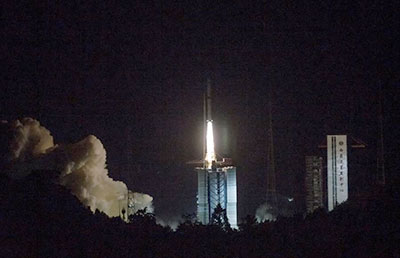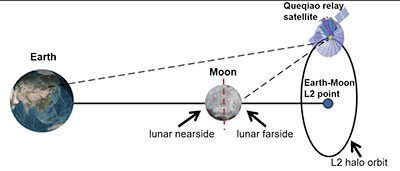 Space News space history and artifacts articles Messages space history discussion forums Sightings worldwide astronaut appearances Resources selected space history documents |
If you have previously registered, but forgotten your password, click here.
"The launch is a key step for China to realize its goal of being the first country to send a probe to soft-land on and rove the far side of the Moon," said Zhang Lihua, manager of the relay satellite project. About 25 minutes after liftoff, the satellite separated from the rocket and entered an Earth-Moon transfer orbit with the perigee at 200 km and the apogee at about 400,000 km. The solar panels and the communication antennas were unfolded. Queqiao is expected to enter a halo orbit around the second Lagrangian (L2) point of the Earth-Moon system, about 455,000 km from the Earth. It will be the world's first communication satellite operating in that orbit.  | ||||||||
| Blackarrow | In such an orbit, will the satellite be in constant line-of-sight contact with Earth, or will it at times pass behind the Moon as seen from Earth? Does China have a system of Earth-orbiting communications satellites capable of maintaining constant between the control centre and the lunar satellite? | |||||||
| Robert Pearlman | Per The Planetary Society: An Earth-Moon L2 halo orbit is ideal for Queqiao because it can 1) provide nearly continuous contact between both lunar farside and Earth ground station, 2) get continuous illumination from the Sun, avoiding eclipses, and 3) requires little energy to maintain its orbit over the long term.  As for the ground stations, gbtimes notes that Queqiao "will rely solely on Chinese facilities, thanks in part to a new, 35m-diameter parabolic antenna in Argentina." | |||||||
| Blackarrow | That's helpful, Robert, but the diagram is clearly not to scale and the description of "nearly continuous contact between both lunar farside and Earth ground station" could mean either that the halo orbit "wobbles" enough to cause occasional occultation; or that there might be a gap in Earth station coverage. Still, they seem to have established a pretty efficient communications link. From memory, the suggestion of an Apollo far-side landing (quickly squashed by NASA) depended on a pair of surplus communications satellites in lunar orbit. I don't remember any suggestion of placing a comsat at L2. Was that beyond NASA's capabilities at the time? | |||||||
| Robert Pearlman | Apparently, NASA considered an L2 halo orbit to support a communications relay for a far side Apollo mission, but ultimately the concept (and, of course, the mission) never came to be. See Lunar Far-Side Communication Satellites (1968). Also, per Wikipedia: Robert W. Farquhar first used the name "halo" for these orbits in his 1968 Ph.D. thesis. Farquhar advocated using spacecraft in a halo orbit on the far side of the Moon (Earth-Moon L2) as a communications relay station for an Apollo mission to the far side of the Moon. A spacecraft in such a halo orbit would be in continuous view of both the Earth and the far side of the Moon. | |||||||
| Robert Pearlman | Xinhua state news agency release China launches new relay satellite for Earth-Moon communications | |||||||
